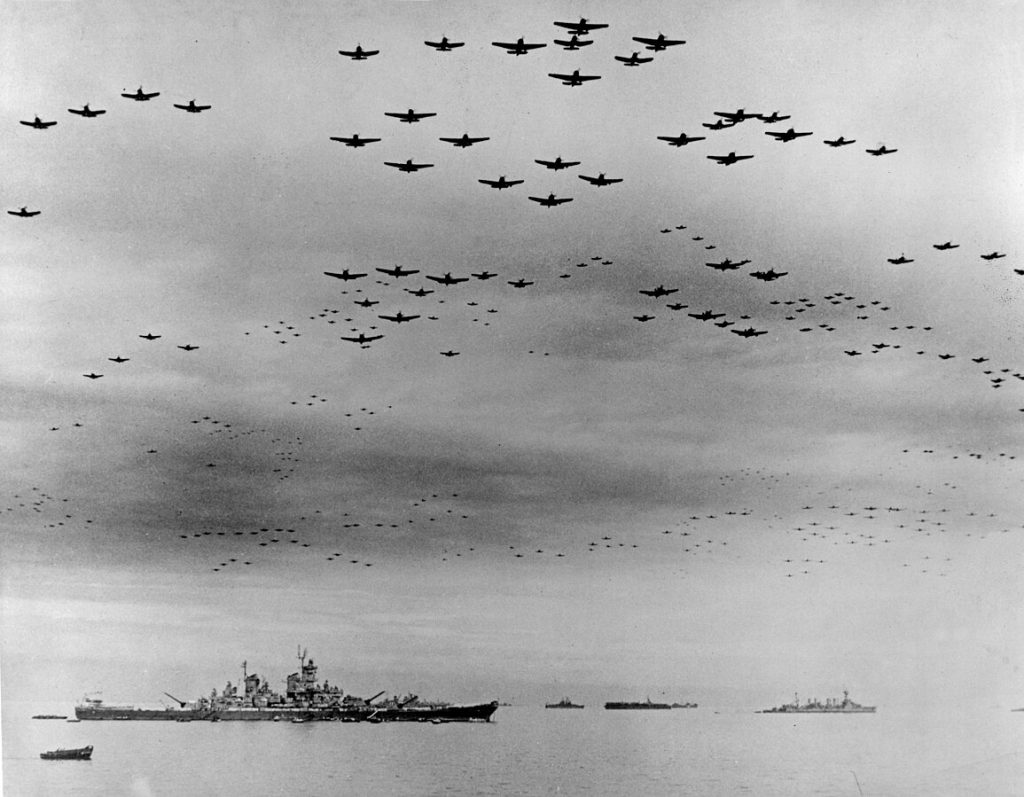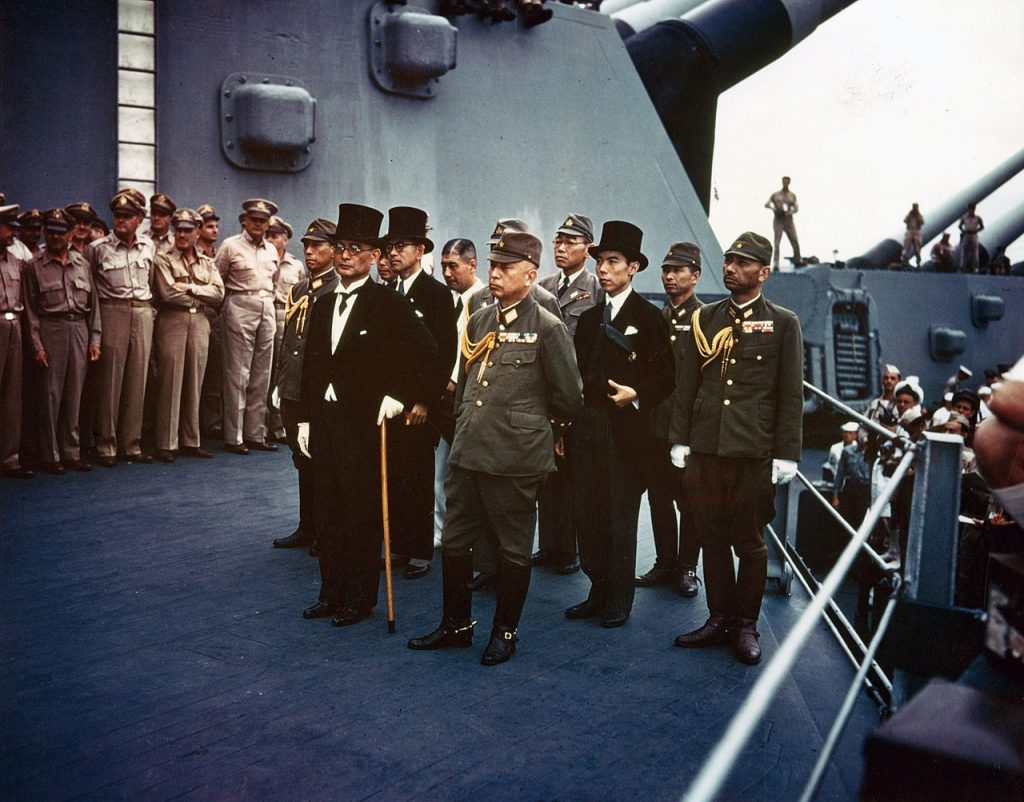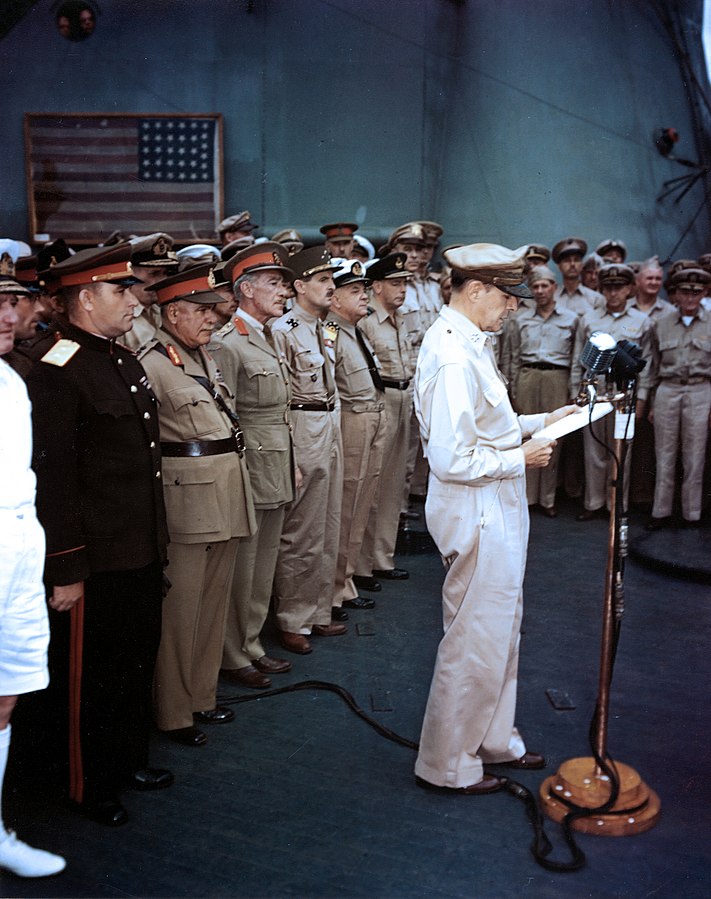The signing of the Japanese surrender on board the USS Missouri on September 2, 1945, marked the end of World War II, a global conflict that had ravaged the world for six years, leaving millions dead and entire countries in ruins.
This momentous event, which took place in Tokyo Bay, Japan, was not just a ceremonial conclusion to the deadliest conflict in human history; it was a carefully orchestrated event that symbolized the transition from war to peace, from despair to hope.
The Setting – USS Missouri
The choice of the USS Missouri as the setting for the Japanese surrender was laden with symbolism and strategic significance, making it a poignant backdrop for one of the most historic moments of the 20th century.
The Missouri, an Iowa-class battleship, was among the largest and most powerful warships ever constructed by the United States Navy.
Commissioned in June 1944, it was a testament to American industrial might and naval superiority during World War II. The battleship’s role in the surrender ceremony was not just a matter of convenience or happenstance; it was a deliberate choice that reflected the United States’ dominant position in the post-war order.
The USS Missouri had been actively involved in the Pacific Theater, participating in battles that were critical to weakening Japanese forces and paving the way for Allied victory. Its presence in Tokyo Bay for the surrender ceremony symbolized the culmination of years of fierce fighting and the ultimate triumph of the Allied powers.
Furthermore, the Missouri held a personal connection to President Harry S. Truman, as it was named after his home state. This added an element of national pride to the proceedings and linked the event to the highest levels of American leadership.
 USS Missouri in Tokyo Bay as a formation of aircraft fly over during the surrender ceremony.
USS Missouri in Tokyo Bay as a formation of aircraft fly over during the surrender ceremony.
The ceremony on the deck of the Missouri was meticulously planned to reflect both the solemnity of the occasion and the hopeful dawn of a new era. The ship was positioned in such a way that it overlooked the bay, with the ruins of Tokyo visible in the distance.
This setting served as a stark reminder of the war’s devastation and the urgent need for peace and reconstruction. The clear skies on the morning of September 2, 1945, added to the atmosphere of renewal, suggesting a world emerging from the darkness of conflict into the light of peace.
The deck of the Missouri was arranged to accommodate the dignitaries and military officials attending the ceremony, with the signing table placed at a central location for all to see. The choice of the battleship’s deck as the venue also underscored the maritime nature of much of the Pacific conflict and highlighted the role of naval power in achieving victory.
It was on this stage that the representatives of the Japanese government formally surrendered, bringing an end to years of bloodshed and opening the door to rebuilding and reconciliation.
The Participants of the Surrender
The surrender ceremony aboard the USS Missouri on September 2, 1945, was a gathering of military leaders and dignitaries from the Allied powers and Japan, each representing their nations at a pivotal moment in history.
General Douglas MacArthur, as Supreme Commander for the Allied Powers, was the most prominent figure at the ceremony. His presence was emblematic of the United States’ central role in the Pacific War and the broader Allied victory. MacArthur’s leadership and strategic decisions had been crucial in turning the tide of war against Japan, making him a fitting figure to oversee the surrender.
Admiral Chester Nimitz represented the United States Navy, which had played a decisive role in the Pacific Theater through major battles like Midway and the island-hopping campaign. Nimitz’s calm and strategic genius had been instrumental in these victories, and his presence underscored the Navy’s contribution to the war effort.
The United Kingdom, a key ally in the fight against the Axis powers, was represented by Admiral Sir Bruce Fraser. The UK’s involvement in the Pacific was significant, especially in the latter stages of the war, as British forces fought in Southeast Asia and contributed to naval operations against Japan.
Lieutenant General Kuzma Derevyanko represented the Soviet Union, which had declared war on Japan in August 1945, quickly advancing into Japanese-held territories in Northeast Asia. The Soviet participation underscored the broad coalition against Japan and added weight to the Allied presence at the surrender.
Representatives from Australia, Canada, France, the Netherlands, and New Zealand, including General Sir Thomas Blamey, Colonel Lawrence Moore Cosgrave, Général de Corps d’Armée Philippe Leclerc de Hauteclocque, Admiral Conrad Helfrich, and Air Vice-Marshal Leonard M. Isitt, respectively, highlighted the global nature of the conflict and the diverse contributions to the war effort against Japan.
Each nation had faced its own struggles against the Axis powers and had made sacrifices that were acknowledged in this moment of victory.
On the other side, Foreign Minister Mamoru Shigemitsu led the Japanese delegation, acting on behalf of Emperor Hirohito. Shigemitsu’s role was deeply symbolic; as a diplomat, his participation signified Japan’s transition from a wartime footing to a peacetime posture.
His attire, a formal morning coat and top hat, contrasted with the military uniforms around him, perhaps signaling Japan’s submission and willingness to enter a new phase of international relations.
 The Japanese representatives on board the USS Missouri before sigining the surrender. Foreign Minister Shigemitsu seen at the front in a top hat.
The Japanese representatives on board the USS Missouri before sigining the surrender. Foreign Minister Shigemitsu seen at the front in a top hat.
General Yoshijiro Umezu, Chief of the Army General Staff, signed on behalf of the Japanese armed forces. His signature was a poignant testament to the end of Japanese military aggression and the beginning of disarmament and demobilization under the terms set by the Allies.
The Japanese Instrument of Surrender
General Douglas MacArthur, serving as the Supreme Commander for the Allied Powers, commenced the ceremony with opening remarks that set the tone for the historic event. His speech was not lengthy, but every word carried the gravity of the occasion.
MacArthur spoke of hope, peace, and the future, emphasizing that the proceedings were more than just a formal surrender; they were a commitment to a better future.
“It is my earnest hope, and indeed the hope of all mankind, that from this solemn occasion, a better world shall emerge out of the blood and carnage of the past,” he declared. This statement reflected the desire not only to conclude the war but to lay the groundwork for lasting peace.
 MacArthur delivers his speech, opening the surrender ceromonies.
MacArthur delivers his speech, opening the surrender ceromonies.
The heart of the ceremony was the signing of the Instrument of Surrender, a document that formally ended the hostilities between the Allied powers and Japan. The process of signing was carefully choreographed to symbolize the surrender and the new hierarchy of power.
Mamoru Shigemitsu, representing the Japanese government, and General Yoshijiro Umezu, on behalf of the Japanese armed forces, were the first to sign.
Their signatures signified Japan’s acceptance of the Allied terms and its commitment to abide by the conditions laid out for its surrender and future conduct.
Following the Japanese delegation, General MacArthur signed the document, both in his capacity as the Supreme Commander for the Allied Powers and on behalf of the United States. His dual signature underscored the central role of the United States in the Pacific War’s conclusion and the broader Allied victory.
After MacArthur, representatives from the other Allied nations — including Admiral Chester Nimitz, Admiral Sir Bruce Fraser, Lieutenant General Kuzma Derevyanko, and others — added their signatures, each in turn, symbolizing the collective victory of the Allies and the united front they presented in both war and peace.
The atmosphere during the ceremony was solemn and charged with the awareness of its historical significance. The participants and witnesses were acutely conscious of the fact that they were part of a moment that would be remembered as long as history was recounted.
The setting on the Missouri’s deck, with the sun shining down and the waters of Tokyo Bay surrounding them, added to the ceremony’s solemnity and symbolism.
The ship, a potent instrument of war, was transformed into a stage for peace, signifying the hope that the end of this conflict would herald a new era of international relations and cooperation.
The ceremony concluded with brief remarks from MacArthur, who called upon the powers gathered to ensure that the peace just signed would be lasting and just.
The ceremony was brief but loaded with significance. It began at 9:00 AM and lasted for about 23 minutes.
The Dawn of a New Era
The surrender ceremony symbolized the transition from a world at war to a period of peace and reconstruction. For the first time in six years, nations could turn their attention from the battlefield to rebuilding their countries and economies. The immediate post-war period saw the initiation of vast reconstruction projects in Europe and Asia, underpinned by programs such as the Marshall Plan, which aimed to rebuild war-torn Europe and ensure the stability and security of the region.
The end of World War II also heralded the creation of the United Nations (UN) in 1945, an organization dedicated to preventing future conflicts and fostering international cooperation. The UN was founded on the principle of collective security, a direct response to the failure of the League of Nations to prevent the Second World War.
The signing of the Japanese surrender not only underscored the need for such an organization but also symbolized the world’s collective desire for peace and a more structured approach to international relations.
While the surrender marked the end of World War II, it also laid the groundwork for the Cold War, a period of geopolitical tension between the Soviet Union and the United States and their respective allies.
The division of Europe and the occupation of Japan set the stage for ideological conflicts that would dominate global affairs for the next several decades.
The occupation and reconstruction of Japan, led by the United States under MacArthur’s administration, transformed Japan into a democratic nation and a key ally of the West, illustrating the strategic realignments that characterized the post-war era.
 USS Missouri in her current state as a museum ship. Image by Stan Shebs CC BY-SA 3.0
USS Missouri in her current state as a museum ship. Image by Stan Shebs CC BY-SA 3.0
The surrender aboard the USS Missouri was a pivotal moment for Japan, leading to profound changes in its society, politics, and economy. Under the Allied occupation, Japan adopted a new constitution that renounced war as a sovereign right and established a parliamentary democracy.
This period of occupation and reconstruction facilitated Japan’s transition from a militaristic empire to a peaceful, democratic nation, setting it on a path to becoming an economic powerhouse and a proponent of international peace and cooperation.
The USS Missouri itself has become a symbol of peace and reconciliation. As a museum ship at Pearl Harbor, near the site of the attack that brought the United States into World War II, the Missouri serves as a poignant reminder of the war’s beginning and end.





